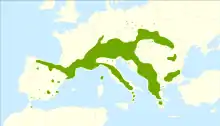Salix eleagnos
Salix eleagnos the bitter willow,[1] olive willow,[2] hoary willow,[1] rosemary willow,[1] or elaeagnus willow,[3] is a species of flowering plant in the family Salicaceae, native to central and southern Europe and south west Asia. Growing to 3 m (10 ft) tall by 5 m (16 ft) broad, it is an erect bushy deciduous shrub with narrow grey-green leaves up to 20 cm (8 in) long, which turn yellow in autumn (fall). The green catkins, 3–6 cm (1–2 in) long, appear with the leaves in spring, male catkins having yellow anthers.[4]
| Salix eleagnos | |
|---|---|
_IMG_37450.JPG.webp) | |
| Scientific classification | |
| Kingdom: | Plantae |
| Clade: | Tracheophytes |
| Clade: | Angiosperms |
| Clade: | Eudicots |
| Clade: | Rosids |
| Order: | Malpighiales |
| Family: | Salicaceae |
| Genus: | Salix |
| Species: | S. eleagnos |
| Binomial name | |
| Salix eleagnos Scop., 1772 | |
 | |
| Distribution map | |
Like all willows, the species is dioecious. The specific epithet eleagnos is frequently spelt elaeagnos (Elaeagnus, silverberry or oleaster), though the original spelling has been accepted as a correct Greek form.[1]
Salix eleagnos subsp. angustifolia has gained the Royal Horticultural Society's Award of Garden Merit.[5][6]
References
- https://npgsweb.ars-grin.gov/gringlobal/taxonomydetail.aspx?id=70587 "Salix eleagnos". Germplasm Resources Information Network. Agricultural Research Service, United States Department of Agriculture. Retrieved 2 June 2013.
{{citation}}: Check|url=value (help) - BSBI List 2007 (xls). Botanical Society of Britain and Ireland. Archived from the original (xls) on 26 June 2015. Retrieved 17 October 2014.
- USDA, NRCS (n.d.). "Salix elaeagnos". The PLANTS Database (plants.usda.gov). Greensboro, North Carolina: National Plant Data Team. Retrieved 26 October 2015.
- RHS A-Z encyclopedia of garden plants. United Kingdom: Dorling Kindersley. 2008. p. 1136. ISBN 978-1405332965.
- "RHS Plant Selector - Salix eleagnos subsp. angustifolia". Retrieved 17 February 2021.
- "AGM Plants - Ornamental" (PDF). Royal Horticultural Society. July 2017. p. 93. Retrieved 12 October 2018.